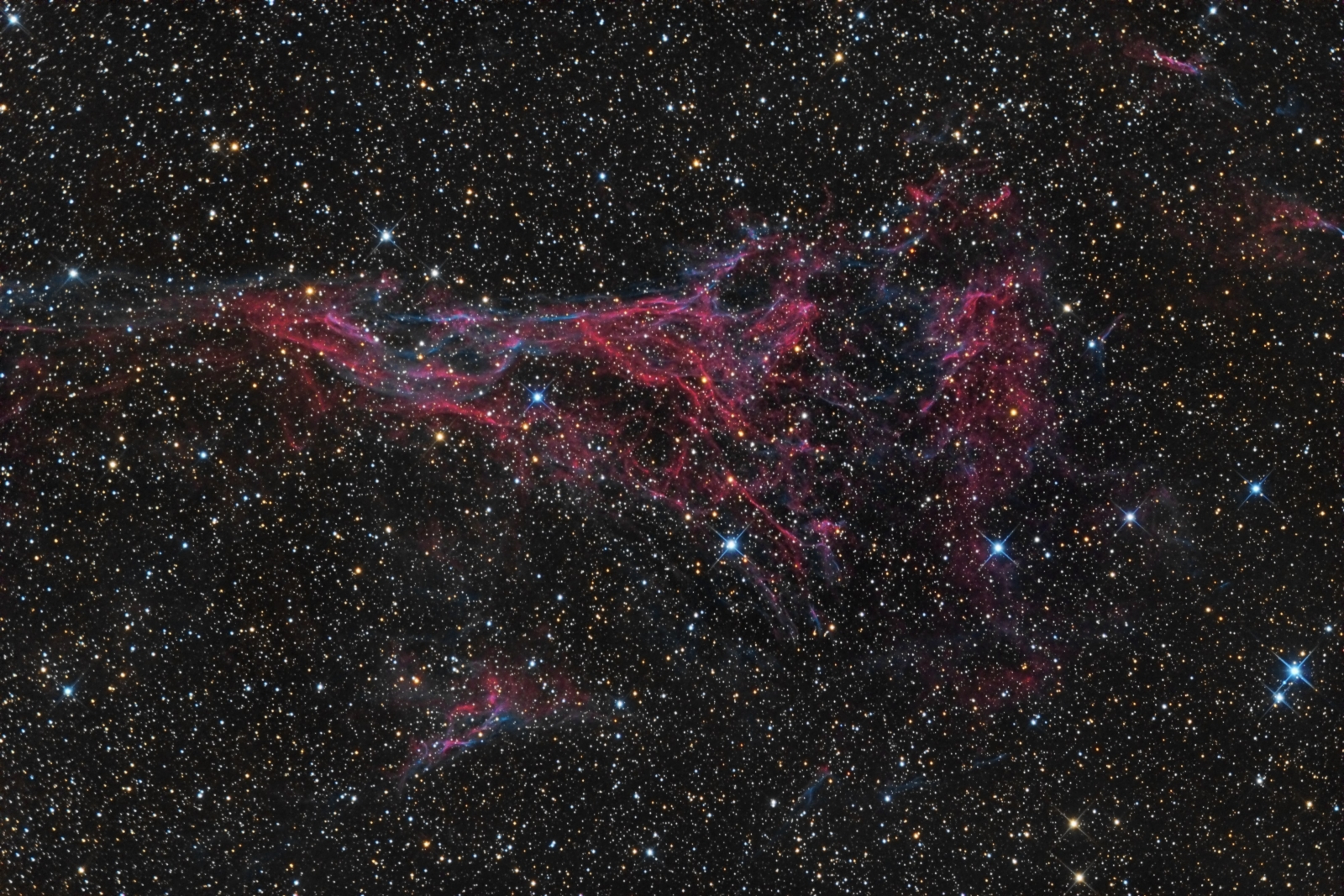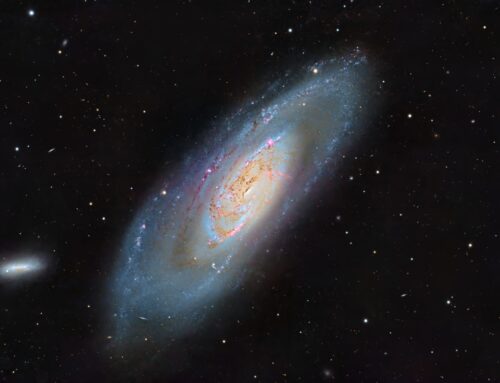Pickering’s Triangle
Click image for full size version
January 3, 2015
Pickering’s Triangle forms part of the Veil Nebula. This image complements images that I have taken of the Western Veil nebula (in HaO3RGB), Western Veil Nebula and part of Pickering’s Triangle, the Eastern Veil Nebula and NGC6979, other portions of this huge supernova remnant, an expanding shell of gas — mainly hydrogen (red) and oxygen (blue/green) left over from an exploding star. The shock waves from the explosion are causing the gas to glow.
The Veil Nebula was discovered by William Herschel in September, 1784. It is a little less than 1500 light years away and is huge in the sky – about 6 times the width of the full moon. However, Pickering’s Triangle wasn’t discovered until it was found photographically in 1904 by Williamina Fleming. However, as was customary at the time, the observatory director, Edward Charles Pickering, was credited with the discovery.
Tekkies:
SBIG STL-11000M camera, Baader HaRGB filters, 10″ f/3.6 ASA astrograph, MI-250 mount. Guided with STL-11000’s internal guider. Focusing with FocusMax. Acquistion, guiding, calibration in Maxim-DL. All other processing in PixInsight. Shot from my SkyShed in Guelph, Ontario. Average transparency and average or below average seeing. No moon.
8x5m R, 8x5m G, 7x5m B and 6x10m Ha (total of 2hr55m).
R, G and B masters were cropped to remove edge artifacts from stacking. The R, G and B channels were combined to make an RGB image which was processed with DBE, Colour Calibration was applied and HistogramTransformation. [NOTE: I didn’t use the NB-RGB script to add in the Ha because it overwhelmed the teal colours in the image. Instead, I included Ha in the synthetic luminance channel – see below].
Synthetic Luminance:
Creation and cleanup: The individual R,G,B and Ha frames were combined using the ImageIntegration tool (average, additive with scaling, noise evaluation, iterative K-sigma / biweight midvariance, no pixel rejection). DBE was applied to neutralize the background.
Deconvolution: A star mask was made to use as a local deringing support. A copy of the image was stretched to use as a range mask. Deconvolution was applied (100 iterations, regularized Richardson-Lucy, external PSF made using DynamicPSF tool with about 40 stars).
Stretching: HistogramTransformation was applied, followed by TGV Denoise and another HistogramTransformation to reset the black point. No pixels were clipped during either stretch. The Curves tool was used to boost brightness, contrast and saturation of the nebula.
Combining SynthL with HaRGB:
The luminance channel was extracted, processed and then added back into the RGB image as follows:
1. Extract luminance from the RGB image.
2. Apply LinearFit using the SynthL channel as a reference.
3. Use ChannelCombination in the Lab mode to replace the luminance of the RGB with the fitted luminance from step 2.
4. LRGBCombine was then used to make a SynthLRGB image.
Multiscale Processing:
Contrast Boost on Large Structure: Small-scale structures were isolated using MultiscaleLinearTransform (8 wavelet layers, residual layer deselected) on a copy of the SynthLRGB image. Large-scale structures were isolated by subtracting the small-scale image from the SynthLRGB (no rescaling). Colour saturation and contrast were boosted on the large-scale image. Then small-scale and large-scale images were added back together in PixelMath.
Saturation Boost on Small Structures: Small-scale structures were isolated using MultiscaleLinearTransform (4 wavelet layers, residual layer deselected) on a copy of the SynthLRGB image. Large-scale structures were isolated by subtracting the small-scale image from the SynthLRGB (no rescaling). Colour saturation was boosted on the small-scale image. Then small-scale and large-scale images were added back together in PixelMath.
Final Steps:
MorphologicalTransformation was applied with a star mask to slightly reduce stars. TGV noise was applied using an extracted luminance channel as a mask. A range mask was used to protect all but the nebula and ExponentialTransformation and an increase in colour saturation were applied to boost the nebula. At this point, there was some dark speckles in the brightest red filaments. CosmeticCorrection was applied to a copy of the image, wioth settings established using a preview of a noisy area. A range mask was made to protect all but brightest parts of nebula. PixelMath was used to replace pixels in the original with pixels from the corrected image.
Image scale for this telescope/camera/rescaling combination is about 2 arcsec/pixel.







Leave A Comment